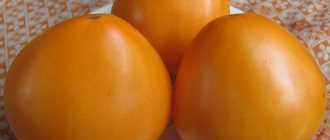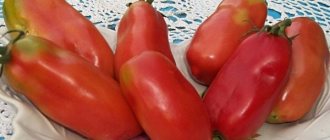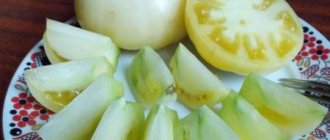The Oxheart tomato is an impressive variety with huge, fleshy, very tasty and juicy fruits. It is ideal for preparing summer salads and tomato juice. Grown tomatoes will become the pride of every summer resident.
| Height | Landing location | Ripening time | Fruit color | Fruit size | Origin | Fruit shape |
| Tall | Greenhouse, Open ground | Mid-season | Pink | Large | Variety | Heart-shaped |
Further care
Bush formation
Since Oxheart has a powerful and spreading bush, it is necessary to prun the bush once a week.
The plant is formed in such a way that 2 main stems remain. The remaining side shoots are removed. It is also necessary to remove all sprouts that form in the axils of the plants. No more than 8 brushes should be left on one stem. If you don't do this, the tomatoes will grow small and tasteless.
Top dressing
Plants grow with an abundance of green mass and a well-developed root system. Also, due to the presence of a large number of large fruits, the bushes need fertilizing. It is carried out up to 3-4 times during the entire growing season.
For the first time, fertilizers are applied 3 weeks after planting the plants in the ground. You can use organic matter or a solution of wood ash, a kilogram of which is diluted in 10 liters of water.
The second time, it is recommended to water with a solution of wood ash.
For the third time, the bushes are fed with potassium fertilizers. They will have a positive effect on the development of fruits, giving them a rich taste and pleasant aroma. Also, potash fertilizers will extend the storage time of the crop.
Watering
Water the plants often and with plenty of water. If the summer is dry, watering is carried out every day in the morning or evening. You cannot water tomatoes during the day. The green mass of the plant may burn and it will die.
Use only settled water. She shouldn't be cold. The soil is moistened only at the root. Otherwise, the bushes may become infected with fungal diseases.
Bedding
Ready seedlings need to be planted correctly.
- Prepare a flat area of field or soil in a greenhouse.
- The holes are marked.
- The holes are spilled with a solution of ash, plus weak potassium permanganate.
- When planting, the seedling deepens to the first pair of leaves.
- A strong support is placed near the future bush or a trellis mesh is stretched.
The area selected for planting seedlings is leveled and future rows of plantings are determined at a distance of up to 70 cm. In a row, holes are filled with a hoe at a distance of up to 50 cm, one from the other.
The bush must be tied up
You can add rotted old mullein to each hole or spill them with a very weak solution of bird droppings. If the seedlings have grown large, they can be placed in the holes at an angle and sprinkled with soil. On the deepened stems, additional roots will sprout, which will supply the plant with nutrition.
Planted tomatoes, our Ox Heart, even they are small, need to be tied to supports and given their direction of growth. After the second node, from the stepson, a second stem is formed, which we leave. Anything later must be deleted. Sometimes it is advised to tear off all the lower leaves for better air access. But the plant produces few leaves anyway, which means this variety does not require their removal.
Nuances of cultivation
Oxheart is a tomato variety that can be easily grown in greenhouse conditions. So why do many gardeners refuse it? It's all about growth. The fact is that this parameter is not limited for the bush.
During cultivation, a tomato needs picking. It is necessary to monitor its growth all the time in order to form a good crown by tying it up. This process is very labor-intensive and time-consuming. It happens that 2-3 large fruits ripen on one crop, the rest dry out.
Good crop yield depends not only on proper picking, but also on fertilizing. Every gardener wants all the brushes to ripen and to have as many of them as possible. The stages of growing this tomato are different, so to get a high-quality harvest, you need to know a few secrets.
Features and description of the variety
The variety was bred in the 90s of the last century in the Russian Federation, and was officially registered in 2000.
Did you know? In different regions of the world, tomato belongs to different botanical groups. The United States classifies it as a vegetable, the European Union as a fruit, and Russia as a berry.
The ox heart has the following characteristics:
- tomatoes are late-ripening varieties - the harvest is harvested 120 days after planting;
- the bushes are of indeterminate type and can reach 200 cm in height;
- The ox heart is characterized by the formation of a large number of lateral shoots, and therefore regular gartering and pinching are required;
- the bush occupies a fairly large area, has dense leaves and medium-length stems;
- the leaves are medium-sized and have a rich dark green color;
- the fruits are heart-shaped (hence the name);
- average fetal weight - 250–300 g;
- up to 8 fruits grow on a bush;
- per 1 sq. m you can grow no more than 4 bushes;
- unripe tomatoes have a pale green color with a dark green spot at the stalk, ripe ones are bright red;
- the peel is thin and can crack if exposed to water under high pressure;
- the pulp is dense and has a juicy taste;
- transportation of fruits occurs normally, but they do not differ in the possibility of long-term storage;
- the variety has no predisposition to any diseases;
- The yield is quite high - up to 7 kg per 1 sq. m.
Appearance
As the name suggests, the fruits of the Oxheart tomato have an interesting heart-shaped shape. There are many such varieties currently bred, but this one can be recognized by its color, which has a crimson tint rather than pink. The shape of different fruits within the same bush may vary slightly in degree of elongation, but in any case, the fruits look exactly like a heart.
Oxheart tomato fruits undoubtedly look attractive
Tomato Oxheart: variety description
Tomato Oxheart: photo of variety
If you compare the Bull's Heart variety and the Ox's Heart tomatoes, you can immediately say that these are completely two different varieties of tomatoes, although it seems that they are similar in appearance and have approximately the same taste. But the main distinguishing feature is the size of the tomatoes and the height of the shrub. The Bull's Heart variety outperforms its brother in all respects.
In 2000, the tomato variety Volovye Heart was bred on the territory of the Russian Federation and was immediately included in the State Register. The variety is considered a late ripening variety, but some gardeners argue that the variety should be classified as mid-ripening. In the northern regions, tomatoes are planted in a greenhouse, and in the southern and central regions this variety can be planted in two versions.
Detailed characteristics of the Oxheart tomato
Bush. It has impressive dimensions. In greenhouse conditions it grows up to 2 m; in garden beds the plant ripens to a height of no more than 1.7 m. The fruits ripen in 3.5-4 months from the period of seedling formation. In outdoor conditions, shrubs produce a small amount of yield - approximately 1 m2, no more than 7 kg. In greenhouse conditions, the yield of Oxheart tomatoes can be increased to 11 kg. Shrubs actively fight late blight and other diseases that are inherent in tomatoes. They like regular watering and fertilizing.
Foliage. A small number of medium-sized leaves, simple in shape. Above the 7th leaf is the first ovary of the plant. Each cluster contains no more than 5 tomatoes of the Ox Heart variety.
Fruit. Oxheart tomatoes are heart-shaped with ribs. The fruits are red-crimson in color. The specific weight of one fruit is no more than 0.3 kg. The tomatoes located at the bottom weigh 0.8-1 kg, and the top fruits are not so large in size and weight - no more than 300 grams. Oxheart tomatoes with sugary pulp, very juicy, with a pleasant aroma. They are easy to transport, since Ox Heart tomatoes have a strong skin due to the fact that the pulp contains dry components. Oxheart tomatoes need to be put into use quickly, as they do not store well.
Root system. Sturdy and strong, highly branched. The central root reaches 1 m in length, the lateral roots from ½ of the bush diverge no more than 3 m.
Oxheart tomatoes are best eaten fresh; they are often used in salads. It's also great for making juice, puree or paste. From 1 kg you get about 0.7 liters of tomato juice. Due to their large dimensions, tomatoes are not rolled into jars uncut. Vegetables can also be pickled or served as a snack.
Advantages and disadvantages of the Oxheart tomato variety
Among gardeners, you can find completely different opinions about the Ox Heart tomato variety; before you decide to purchase seeds, you need to analyze the pros and cons.
The advantages include:
- Large size tomatoes;
- First-class presentation;
- Great taste;
- The productivity of the Oxheart tomato is high if all care rules are followed;
- Has good immunity that can resist diseases.
Disadvantages of the Oxheart tomato:
- The vegetable needs constant and proper care;
- The variety has a fairly long period of active growth, which is unlikely to be suitable for all climatic conditions;
- The variety is very sensitive to temperature changes, you need to be very careful with this indicator;
- Oxheart tomatoes are perishable and not suitable for long-term storage.
Characteristics of tomato Batyanya
The vegetable in question has a number of popular varieties.
This subspecies was obtained by folk breeders. It is distinguished by earlier ripening, smaller fruit sizes (300–400 g), and a small number of seeds in the pulp. Grow a plant with 2–3 stems. The color is bright pink. There is a sweet taste and sugar content.
It stands out for its appearance: the fruits have a golden-pink hue and yellow-green stripes along the surface. Their weight is noticeably less than the original variety; on average, a tomato weighs 200 g. However, they have a rich, sweet taste. The ripening period of tomatoes is mid-early. It is recommended to grow this subspecies in greenhouses. Bush height 120–130 cm.
The Ox Heart variety is considered a mid-season crop. Tomato ripening occurs 115–125 days after planting. The fruiting time is somewhat extended, which is possible and good, because you can collect vegetables from the bushes for just a month.
According to the description in the register, the yield of the Oxheart tomato is 7 kg/sq. m. Per 1 sq. m it is recommended to plant 4 bushes.
Attention! The yield of a variety is directly affected by proper compliance with growing conditions.
Unfortunately, the photo cannot convey the taste that the Oxheart tomato has. Concentrated tomato juice is highly valued. The volume of the resulting liquid is 700 ml/kg. Tender, sweet pulp is suitable for fresh vegetable salads. Its sweetness and sugar content depends on the number of sunny days. The variety is not suitable for pickling and canning due to the large size of the fruit.
This variety does not have long-term storage; tomatoes must be quickly sold or processed. Not prone to cracking.
Important! Thanks to its dense skin, the Oxheart tomato can withstand transportation over long distances without losing its presentation.
The Oxheart tomato variety is not distinguished by good health and high immunity. The vegetable crop is moderately resistant to typical tomato diseases.
Important! Harmful insects rarely attack Oxheart tomatoes.
Reviews and photos of those gardeners who planted the Ox Heart tomato variety are quite contradictory. Obviously, the plant has strengths and weaknesses. Advantages:
- large fruit;
- marketable condition;
- high yield with proper care;
- possibility of growing in greenhouse conditions and in open ground;
- dessert taste;
- transportability.
Among the negative aspects of this variety it is worth noting:
- the need for tying and pinching;
- lack of long shelf life;
- reacts sharply to sudden temperature changes;
- long growing season.
Attention! Despite significant shortcomings, Ox Heart tomatoes are in demand among gardeners. Some people independently take the variety as a basis and develop new subspecies.
Features of cultivation and care
Tomatoes of the Ox Heart variety are late-ripening vegetables, therefore they are grown by seedlings.
Sowing seedlings
Sowing tomatoes begins with calibration and processing of planting material.
1. The seeds are carefully sorted, leaving only whole and dry specimens without any signs of putrefactive lesions for planting.
2. Next, the seeds are dipped in a manganese solution for 20-30 minutes, then treated with a growth stimulator.
3. The treated material is placed in a damp cloth and placed in the bottom drawer of the refrigerator for 48 hours.
4. After hardening, the seeds are placed in a warm room and left for another 2-3 days for germination.
5. Before planting seeds, containers are thoroughly washed and treated with antibacterial agents.
6. Place drainage at the bottom of the container, and pour fertile soil mixture on top.
7. Make holes on the surface of the soil no more than 2 centimeters deep.
8. The distance between the seeds is left 2-3 centimeters.
9. Place one seed in each hole and cover it with soil.
10. Containers with plantings are covered with film or glass and transferred to a warm place.
11. After the sprouts appear, the film is removed, the plants are moved to a well-lit room with a constant temperature of +22 to +25 degrees.
12. As soon as the seedlings have 2-4 leaves, the plants are picked, carried into different pots or spacious boxes.
Important! Caring for seedlings includes timely watering and fertilizing with minerals.
Hardening and transplanting seedlings
10-14 days before planting seedlings in open ground, hardening of the bushes begins, taking them outside for 3-4 hours every day or placing them in a cool room.
The timing of tomato transplantation depends on the climatic and weather conditions of the region and growing methods.
Seedlings are transferred to open ground at the age of 60-65 days. For greenhouse cultivation, work is carried out 2-3 weeks earlier.
Selecting a location
Choose a site for planting tomatoes that is well-lit, protected from drafts and gusts of the north wind.
1. Prepare the soil for seedlings in advance.
2. The soil is dug deep, mixed with organic matter and minerals, and thoroughly loosened.
3. Add ash or lime to soil with a high acid content.
Important! Tall bushes require stakes or support structures for additional support.
Optimal scheme
Seedlings are planted as soon as the soil warms up to +14-16 degrees. In the southern regions, planting begins in mid-May. In temperate latitudes, tomato planting is planned for early June.
1. Before planting tomatoes in prepared beds, dig planting holes up to 30-40 centimeters deep.
2. The distance between tall bushes is left up to 60-70 centimeters, between beds - up to 1 meter.
3. Seedlings are transferred to each hole, carefully removing them from the container along with a lump of earth.
4. The bush is covered with fertile soil and moistened abundantly.
5. The beds are mulched with a layer of compost or sawdust with peat.
Important! The planted bushes are secured to supporting structures or tied to pegs.
How to grow seedlings
“Oxheart,” like all tomatoes, grows well in light, fertile soil consisting of humus, peat and sand. The beds should be located in a sunny area without wind.
Preparing for landing
Before planting tomatoes in open ground or in greenhouses, seedlings are first grown. Seeds can be bought in the store, but experienced vegetable growers advise saving them from the previous harvest.
When choosing seeds from suppliers, pay attention to the integrity of the packaging and expiration date. Discard small seeds immediately
Healthy, strong plants will only grow from large, whole seeds.
If you decide to prepare the planting material yourself, follow the instructions:
- Two to four weeks before sowing, test for germination. To do this, wrap several seeds in a wet cloth and soak them in warm water for a day. Leave the seeds uncovered on a damp cloth for three to four days. Then they can be sown.
- Planting material should be disinfected with a solution of potassium permanganate (1%), “Fitosporin” or another product. Dip the seeds wrapped in gauze into the solution for 15-20 minutes, then rinse with clean water. If you use potassium permanganate, then take 1 g of the substance per 1 liter of water. When using other disinfectants, follow the instructions on the package.
- In order to increase disease resistance and germination of tomatoes, treat the seeds with regular wood ash or ready-made microelements. For 250 g of water, use one teaspoon of ash. Insist for one day. Then soak the seeds for 3-4 days. Afterwards they should be rinsed. In order for the seeds to germinate better, a day before planting, place them on a damp cloth and leave them in a warm place.
Oxheart tomatoes are sown two months before planting under film, in a greenhouse or open ground - in the first ten days of March.
Care
Planting material is sown in moist soil to a depth of 2-2.5 cm and placed in a warm, sunny place. The temperature should be maintained around 20–22 °C. The box with seedlings can be covered with film, so the tomatoes will sprout faster. When the second leaf appears, the seedlings are planted in separate containers with nutrient soil.
Before planting in the ground, seedlings are hardened off. In 10-12 days it is taken out into the fresh air. First, the plants are left for a couple of hours, gradually increasing this time to 12 hours. If there is no frost, the seedlings can be taken out into the fresh air overnight in the last days before planting.
general description
This variety cannot be classified as new, since it was bred at the end of the 20th century and entered into the register in 2000. The tomato was obtained by Russian breeders. It can be praised for its very large fruits, somewhat shaped like a heart. This favorite of summer residents is very productive and unpretentious. The variety is intended more for warm and temperate climates, but over many years, summer residents have proven that “Ox Heart,” if planted in a greenhouse, produces stable, high yields in Siberia, the Urals, and the Far East.
Tomatoes have many advantages, one of which is that the fruits do not crack and can be easily transported. All this makes growing the variety for sale very profitable; it pays for all labor costs. More details below.
Brief characteristics of the variety
Ox heart is often found in vegetable gardens. This tomato variety is valued for its large fruits with very juicy and tasty pulp. As gardeners themselves say, most often it is used fresh, as well as for preparing salads, although it is ideal for canning. Of course, it won’t be possible to place the whole fruit in a jar, because some fruits reach a weight of 1 kg, and if you cut it into halves or quarters, it will not hold its shape. So it is best to use it for preparations as an additional component in lecho, stew, saute, or to cover juice from it (especially since from one kg you can get up to 700 grams of this product), pasta, ketchup, etc.
Up to five fruits are formed on one formed cluster. The color of a ripe tomato is rich with a glossy sheen.
More about the variety
First of all, it is worth noting that the characteristics and description of the Ox Heart tomato variety are different from the Bull Heart tomato: these are two completely different varieties. Although the fruits of these varieties do have an external similarity and almost the same taste. The main difference between the two types is the height of the bush and the size of the fruits: after all, the Bull's Heart is larger in all respects.
The tomato variety Volovye Serdtse was bred in Russia in 2000, at which time it was included in the State Register. This tomato is considered late-ripening, although some breeders classify it as a medium-ripening tomato. Therefore, it is recommended to grow this variety in the southern and central regions; in the North, Heart is planted only in a greenhouse.
Description of the tomato variety Oxen Heart:
- bushes of indeterminate type, their height in a greenhouse reaches two meters, in open ground - no more than 170 cm;
- tomatoes ripen 107-118 days after emergence;
- There are not very many leaves on the bushes, they are of medium size and regular in shape;
- the tomato yield in open ground is not very high - up to 7 kg per square meter; in a greenhouse it is possible to raise this figure to 11 kg;
- the Volovye Serdtse variety has complex resistance to “tomato” diseases, including late blight;
- the tomato responds well to fertilizers and regular watering;
- the first floral ovary is usually located above the seventh leaf;
- Each brush can form up to five tomatoes;
- the average fruit weight is 350 grams;
- the lower tomatoes reach a size of 800-1000 grams, the upper ones are smaller - 250-150 grams;
- the shape of the fruit resembles a heart - an elongated ribbed oval;
- the color of the tomatoes is raspberry-red;
- the pulp is sugary when broken, tasty, very sweet, aromatic;
- tomatoes are suitable for transportation because they have a dense peel and their pulp contains a lot of dry matter;
- The harvested crop will not be stored for long, so you need to sell the fruits faster;
- The root system of this variety is very powerful - the length of the central horse can reach a meter, the lateral roots often branch 2-2.5 meters from the middle of the bush.
The Ox Heart variety is considered a salad variety, that is, it is best to eat tomatoes fresh. These tomatoes make very tasty purees, pastes and juices. One kilogram of fruit yields 700 ml of tomato juice. It will not be possible to preserve the Ox Heart tomato in its entirety, since its size is quite large. But tomato looks great in pickled salads and appetizers.
Advantages and disadvantages
The Ox Heart variety is quite controversial: the opinions and reviews of gardeners about this tomato are the most contradictory. Therefore, it is worth highlighting the strengths and weaknesses of the Heart.
The advantages include:
impressive fruit size; highly marketable appearance of tomato; excellent taste of tomatoes; good yield (with sufficient care); average resistance to diseases (which is very important for a late-ripening variety).
Heart-shaped tomatoes also have disadvantages:
- plants require constant and competent care;
- the variety has a long growing season, which is not suitable for every climate;
- temperature is very important for the Ox Heart - the tomato does not like fluctuations from heat to cold;
- It will not be possible to preserve the harvest for a long time - the fruits quickly deteriorate.
Subspecies of the variety
Of course, the tomato in question cannot boast as many varieties as its brother, the Bull's Heart variety (there are pink, striped, and black-fruited tomatoes and many other types). But the Ox Heart also has a couple of popular varieties:
Tomato Minusinsk Ox Heart
Brought out by folk breeders. It differs from its predecessor in earlier ripening periods (mid-season variety), slightly reduced weight of fruits (limits from 200 to 400 grams are indicated), and a small number of seeds inside the tomatoes. It is recommended to grow this variety in two or three stems.
Ox Heart Striped
It is easy to recognize by the appearance of the fruit: the tomatoes are golden-pink in color, with yellow-green stripes clearly visible on the peel. The tomatoes are smaller than those of the predecessor variety - 150-200 grams, but they are very sweet and tasty. It is recommended to grow this subspecies in protected ground. Its ripening period is average, the bushes are not so tall (up to 130 cm).
Subspecies of the variety
The Ox Heart variety has two subspecies - Minusinsk and Striped.
The first variety was bred by folk breeders. Differences from the main species include an earlier period of fruit ripening and the size of the fruit. The Minusinsk subspecies has smaller fruits. The striped heart is easy to recognize by its appearance. The fruits of this subspecies are golden-pink, with yellowish-green stripes visible on them. The subspecies belongs to the mid-season. The tomatoes are small, but sweet and tasty. Due to their compact size, striped tomatoes are suitable for canning as a whole. The height of the Oxheart striped tomato bushes reaches 1.3 m. They are also formed into a maximum of two stems.
Landing
The tomato is considered heat-loving, so it is grown in open ground only in the southern regions. For the middle zone, planting in a greenhouse is suitable. The timing of sowing seedlings depends on the planting zone. On average, it is carried out 2 months before planting in a permanent place.
Growing seedlings
For seedlings, the soil is prepared in the fall. It is bought in a store or made from sand, peat, deciduous soil and humus, taken in equal proportions. Seeds purchased at the store do not need to be processed before sowing. If the seed is collected independently, it must be checked for germination and disinfected. To do this, place the seeds in a 1% manganese solution. Those that do not sink should be discarded, and the remaining ones should be left for an hour to disinfect.
After the procedure is completed, they are dried on a paper towel and placed on the ground.
It is important to maintain a distance of 2 by 2 cm between the seeds. Sprinkle a small amount of soil on top, water everything thoroughly and carefully, and then cover with film. After germination, it is placed on a windowsill with bright lighting, and the covering is removed
To prevent the seedlings from growing elongated and unsightly, they are kept at a temperature of 18-22°C. When there is not enough natural light, additional illumination is carried out with a lamp.
After germination, it is placed on a windowsill with bright lighting, and the covering is removed. To prevent the seedlings from growing elongated and unsightly, they are kept at a temperature of 18-22°C. When there is not enough natural light, additional illumination is carried out with a lamp.
Landing in the ground
This stage occurs after warm weather sets in without further cold snaps. The soil should be very nutritious and loose. 25 kg of humus is added to the future site of the bed in October, and in the spring 80 g of superphosphate and 20 g of potassium chloride are added, and then carefully dug up. An important condition when growing this variety is the timely installation of support to support the trunk of the plant.
The sequence of the transplant process:
- planting holes are formed;
- a stake is driven into the center of each hole;
- seedlings are distributed;
- the roots are thoroughly watered;
- the holes are filled up and mulched.
Growing rules
To get good yields of the Oxheart tomato, you will have to work hard, since the variety requires attention. Like other late-ripening plants, it prefers light, overheated, fertile soils. It will be necessary to form a bush, pinching, tying, and controlling the ovaries.
Planting seedlings
Before purchasing pink Oxheart tomatoes at specialized outlets, you need to pay attention to the integrity of the packaging and the expiration date of the seeds. As a rule, the manufacturer has already carried out preliminary preparation of planting material:
- sorting;
- disinfection;
- treatment with growth stimulants.
This saves a lot of time, but affects the price.
Sowing Oxheart tomato seeds for seedlings begins 60 days before the intended planting in a greenhouse or in open ground beds. The substrate should be loose, nutritious, and well-drained. Peat composition, turf or humus soil are optimal. Low acidity required.
After about 3-4 days, the seeds will sprout. Then you should stop covering them and move them to the light. Reduce the temperature by 6–7 °C, which will strengthen the root system and prevent the plants from stretching upward too much. When two leaves appear, the seedlings begin to dive.
Tomato transplant
At the age of 55–60 days, it is recommended to plant the seedlings in a permanent place. The procedure must be carried out after the cessation of night frosts. The variety is tall, so it is recommended to plant it on 1 square meter. m no more than three or four bushes. The distance between the holes is 50–55 cm, and the row spacing is 35 cm.
Tomatoes will develop well if cabbage, carrots, dill, zucchini, cucumbers, and legumes grew on the plot last year. The vegetable does not like heavy, dense soils, which do not allow the root system to fully form. Before planting, 10 g of superphosphate is poured into each prepared hole.
Advice! Tomatoes that are more resistant to weather conditions can be obtained by hardening the seedlings, which is carried out 2 weeks before planting. Boxes with seedlings are taken outside for several hours so that the tomatoes get used to the ambient temperature.
- When the Oxheart tomatoes reach a height of 30–35 cm, it is time to tie them to vertical supports. To do this, a stake is built near the hole, and a stem is tied to it so that it does not break under the weight of the fruit.
- The bush forms two stems. The lower foliage is cut off to the first brush. Stepchildren are also regularly removed.
- Humidification for Oxheart tomatoes requires plentiful moisture. About three times a week, as the soil under the bushes dries out. It is advisable to use warm water for irrigation.
- After water procedures, the next day it is necessary to loosen the soil. For better air circulation, the lower leaves are removed.
- Mineral and organic fertilizers are applied until the fruit begins to form. A mullein solution with the addition of nitrophoska works well. The frequency of fertilizers is 4 times per season.
- An equally important procedure is the removal of weeds from the beds.
- A layer of mulch retains moisture well in the soil and prevents weeds from germinating. It is made from dry grass and straw 20–30 cm thick.
- It is useful to scatter wood ash around the tomato bushes.
Attention! It is necessary to collect the fruits of tomatoes of the Oxheart variety immediately after ripening, since their mass significantly makes the bush heavier. The stem may not hold up and break off.
Advantages and disadvantages of the variety
This variety is quite unique in cultivation and care, however, it has a number of undeniable advantages and advantages.
Pros:
- It is not a hybrid, but a varietal one. This means that it is not necessary to buy seed material for the next season. You can prepare it yourself;
- It has a rich, bright sweetish taste that reveals all the benefits of fresh tomatoes, especially if it is freshly squeezed tomato juice;
- The presence of large fruits, well suited for preparing delicious salads and rich juices;
- No tendency to diseases typical of tomato bushes, such as late blight.
Minuses:
- Requires constant attention: the need for pinching, tying, intolerance to lack of moisture;
- There is no possibility of canning in its entirety;
- Only the southern regions of the country allow cultivation in open ground.
All of the above shows that for beginning amateur gardeners, growing the Ox’s Heart variety can become an ordeal that will discourage all desire to grow tomatoes. However, with proper care and constant attention to the crop, it will certainly delight you with a wonderful harvest, which every summer resident will remember in winter with a glass of delicious chilled tomato juice in his hand.
Reviews
The popularity of the Ox Heart variety becomes clear if you look at the reviews and photos: massive, appetizing fruits always attract attention.
Natalya, 52 years old: “Before, my favorite tomato variety was Bull’s Heart; my grandmother grew it. A friend advised me to replace it with a more modern version - Ox Heart. This variety turned out to be more productive and sweeter. The bushes do not stretch much. I make sure to remove all the stepsons, otherwise the tomatoes will become smaller.”
Sergei, 67 years old: “I retired and started working in the garden. I grow seedlings and tomatoes for sale. Of course, I also provide my family with vegetables. There are many favorite varieties, among the raspberry varieties is Ox Heart. It grows in my greenhouse. In terms of yield, it is inferior to hybrids, but superior to them in taste, especially if it ripens on the bush.”
Are ox heart and ox heart the same variety of tomatoes?
always elegant
it became the most interesting! I didn’t pay attention before, I thought it depended on the soil (my mother has clay and ox’s heart is red, I have sand and ox’s heart is pink!!! And at my neighbor’s I saw a yellow ox’s heart (I don’t like yellow tomatoes!). I’ll go surf on other sites !!!
Marina Crow
Different. The oxtail is larger. at least I have grown
- The latest tomato varieties
- Tomato varieties in open ground
- Picking tomato seedlings
- Planting tomatoes in a greenhouse
- Diseases of tomato seedlings
- Early tomatoes
- When to plant tomatoes in Siberia
- Growing tomato varieties
- Varieties of tomatoes for the balcony
- How long are tomato seeds soaked?
- Growing tomato seedlings ganichkina
- Tomato seed treatment before sowing
- The earliest varieties of tomatoes
- Caterpillar on tomatoes
- The largest varieties of tomatoes
- Seed treatment before sowing tomato
Features of growing tomato
Once you plant Oxheart tomatoes, the cultivation will not be much different from other tomatoes, except for the formation.
This variety of tomato has large fruits that break off the shoots under their weight. To avoid troubles, fruit tying must be carried out in a timely manner and more carefully. By picking up each inflorescence during the period of fruit formation and strengthening it, we promote fixation and can avoid loss of harvest.
Growing a tomato is the main activity that will allow you to get large fruits. Regular and constant removal of stepsons will prevent the outflow of nutrients from the fruits, and forming them into one stem will allow you to get large and especially large fruits.
A tomato bed for large-fruited tomatoes should be prepared more carefully to make it possible to feed the large body of the fruit.
Since the variety is late-ripening, in order to speed up fruiting it is necessary to take care of the seedling crop in advance. By sowing seeds in March in a heated greenhouse or apartment, we can speed up the formation of fruits by almost a month.
The tomato is recommended for growing in the garden and in greenhouses by small producers and farmers. 12 - 15 years ago, when the popularity of this variety was just gaining momentum, it was on the lips of everyone who planted at least a few tomato bushes in the garden. However, with the advent of more productive, early and versatile varieties and hybrids, the excitement subsided. However, there are still lovers who do not betray their “heart” tomato, cultivating it both in the garden and in greenhouses.
Features of agricultural technology of tomato Ox's heart
Most tomatoes are grown through the seedling stage, and late-ripening ones even more so. This also applies to the Ox Heart variety.
Planting and caring for seedlings
In the middle zone, efforts to prepare seedlings begin in March. The specific number depends on the climate of the region: the further south, the earlier, and at a latitude, for example, the Moscow region, if film shelters are not used, seedlings are transferred to open ground only at the beginning of summer. Since she should be about two months old, sowing seeds can begin around March 20 (earlier for greenhouses).
Growing tomato seedlings of this variety is carried out in the traditional way.
- After calibrating the seeds, they are disinfected for 20 minutes in a dark solution of potassium permanganate and hardened in the refrigerator for 2–3 days.
If the package of seeds says that they have been prepared, it is better to sow them dry
For sowing, you can take any waste box
Before picking, the box (box) is kept on a cool windowsill
It is better to dive into peat pots
The main thing when growing seedlings is that they do not stretch
Good seedlings are stocky, 20–25 cm high, with a thick stem. If the soil has warmed up to 14–15 o C, and the night frosts have passed, it can be planted in a garden bed, but it is advisable to cover it with spunbond for the first time.
Planting in the ground and further care
The indeterminate variety requires a lot of space, so Ox Heart is planted no thicker than 50 x 70 cm. Since the roots do not need to be buried deeply, seedlings that are longer than required are planted obliquely, buried almost to the first leaves. Immediately drive in stakes for the garter, and if convenient, build a common trellis. Good watering of seedlings during planting and mulching of the soil are required.
When caring for a plant, they water, remove weeds, loosen and mulch the soil, give fertilizing and always shape the plant. All operations are common for indeterminate varieties. This variety requires abundant watering, but stop it as soon as the tomatoes begin to turn brown, otherwise cracking is inevitable. Top dressing is given every 3-4 weeks: first with an infusion of mullein, then with an infusion of 20 g of superphosphate and a handful of ash in a bucket of water.
The Ox's Heart is formed into 1 or 2 stems: the second stem is used to make a strong stepson located above the first inflorescence. The remaining stepsons are systematically broken out when they reach a length of 4–5 cm. If more than 6–8 brushes have formed on the bush, the next ones are removed: the variety will not stretch that many. After the formation of each brush, the leaves located under it are torn off. The bushes are tied several times a season as the stems grow.
When the time comes and a sufficient number of brushes have developed, the top just needs to be cut off
If this variety is highly resistant to diseases, they try not to spray the bushes again, but before flowering begins, it is advisable to walk over the leaves and soil with 1% Bordeaux mixture. In a greenhouse, growing Oxheart is carried out in a similar way, but do not forget to ventilate the room.
How to grow Oxheart tomatoes
Tomatoes of the “Ox Heart” variety are grown on light, fertile soils. It is not advisable to plant tomatoes in the same place year after year. Use soil after carrots, peas, onions or radishes. This applies to tomatoes growing in open ground.
In a greenhouse where it is difficult to comply with crop rotation rules, it is recommended to prepare the soil in the fall. It is dug up with humus and mineral fertilizers. Feed the plant 2-3 times during active growth. A potassium-phosphorus mixture and a small amount of nitrogen fertilizers are used as fertilizer.
Planting, care and cultivation features
The seedlings are ready for replanting at 55–65 days. The soil after planting onions, radishes, peas, carrots, and beans is considered good. After them, the tomatoes bear fruit well and do not get sick. The soil temperature should be above +8 °C, but it is still recommended to wait until it is 12-15 °C.
“Oxheart” tomatoes are planted at a distance of 35-50 cm from each other. The hole should be no more than 20-25 cm deep. The distance between the holes is 45-50 cm. A gap of up to 90 cm should be left between the rows. Immediately after planting, the trunks tied up. The planting density should be no higher than four bushes per 1 square meter. The bush is formed from one or two trunks.
To form the second stem, leave the stepson below the first brush. All other stepsons are deleted. Watering should be done after the heat subsides (in the evening), and only with warm, settled water. Mulching (laying various special materials on the beds) protects the soil from drying out.
Be sure to tie the bushes to a vertical support so that heavy fruits do not break the branch. After the fifth or sixth cluster with an ovary has formed, the crown is pinched after three to five leaves.
If you leave all the tomatoes that have set, the fruits will be small and unripe. In greenhouses, conditions are more favorable for plant development, and the temperature remains longer. Therefore, up to seven clusters with ovaries are left on the shoots.
Diseases and pests
The “Ox Heart” variety is resistant to late blight and other fungal diseases. If the plant is sick, the cause could be a carelessly broken branch, lower leaf or stepson. The appearance of fungus can be caused by proximity to cucumbers or potatoes.
If you see signs of late blight infection or rot, treat the shoots with special preparations. Most early tomato diseases (white, brown, gray rot) can be dealt with by spraying the plants with a solution of potassium permanganate and garlic. For 10 liters of water take one head of garlic and 1 g of potassium permanganate.
If a tomato looks unhealthy, then some signs can reveal the cause. Let's consider the possible options.
If the leaves on the trunks begin to turn yellow
Yellow leaves are cut off on the main stem. The reason for this is a lack of moisture in the root system. Seedlings planted in the ground should be watered in the hole, and not poured water onto the surface of the ground after hilling. It is this method of watering that promotes the formation of root growth at the top (it reaches for moisture).
Weak shoots growing close to the ground dry out quickly, resulting in yellowed leaves.
If the leaves curl
Tomatoes should not be sprayed with water from sprayers. Moisture on leaves under the scorching sun is a conductor of heat. This damages the leaves of the plant.
Main characteristics
Tomatoes of this variety are classified as indeterminate, but do not produce a generous harvest.
- Ox's heart is a late-ripening tomato; according to some plant growing reference books, it is mid-ripening. The ripening time of its first fruits, counting from the day of planting the seeds, is 107 - 117 days.
- Plants of this variety are indeterminate, although some vegetable growers tend to classify them as semi-determinate. The average height of the "Ox Heart" bushes is 1.2 - 1.4 m, but some specimens grown in greenhouses can reach 1.8 - 2 m. The plants are powerful, like most other salad varieties, with little foliage. The leaf blades are rich green, medium in size, and have a standard “tomato” shape.
- The yield of the variety is low - on average, during the growing season, one bush of ground tomatoes produces 4.8 - 7.0 kg of fruit, but when cultivated in a greenhouse, this figure increases to 8.0 - 11.0 kg.
- “Oxheart” responds well to fertilizing, is rarely affected by late blight, and has complex disease resistance.
Excellent harvest of these tomatoes










